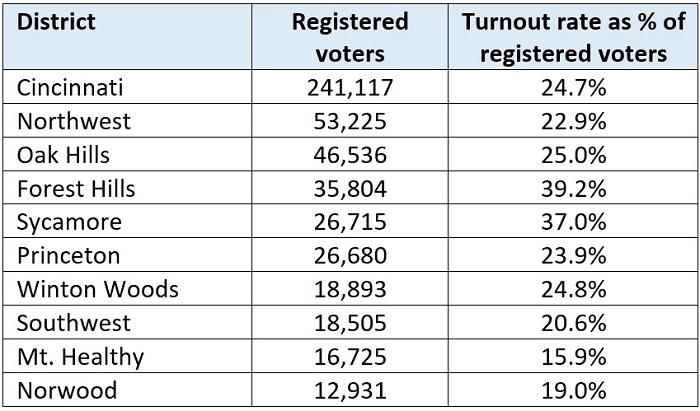It’s September and that means fall elections are coming soon. Not that election—the presidential is still more than twelve months away—but local school board races are right around the corner. These are important contests, as school boards play a critical leadership role in public education, but if history is any indication, turnout will be small.
First, why are school boards so important? These bodies establish the academic policies and priorities that drive district actions. They adopt curricula and instructional materials and institute policies that heavily impact the daily work of educators. They make budgetary choices about which programs are funded or cut, and with district administrators, they negotiate sprawling, multi-million-dollar employment contracts with the unions. They also make decisions about putting local tax requests on the ballot, which can directly impact citizens’ finances. Last but not least, their attitudes and values can influence the way districts respond to the sensitive, sometimes charged, issues that arise in education.
Despite the significant powers and responsibilities of school boards, appallingly few citizens vote in these elections. One key reason for the low turnout is their “off-cycle” timing. School board races—along with other municipal elections, per state law—are held in odd-numbered years when national and statewide elections are off the ballot. That needs to change, and here’s why.
Table 1 shows the sharp differences in turnout for the most recent fall elections in Ohio’s three most populous counties. In Cuyahoga County, an abysmal 27 percent of registered voters participated in the fall 2021 off-cycle elections when school board races were contested. Meanwhile, 71 percent of the county’s voters went to the polls in fall 2020—a presidential election—and 47 percent voted in fall 2022 (mid-terms). The turnout patterns are very similar in Franklin and Hamilton counties.
Table 1: Voter turnout rates for off-cycle (2019 and 2021) and on-cycle (2020 and 2022) elections

Given these countywide numbers, turnout for school board races at an individual district level are predictably low. Just a quarter of Cincinnati voters went to the polls to choose district board members in the 2021 cycle. Less than 20 percent of voters in Mt. Healthy and Norwood turned out.
Table 2: Voter turnout rates in ten largest Hamilton County districts by voter registration, fall 2021

Low turnout shouldn’t be laid at the feet of citizens, many of whom are busy with occupational and family responsibilities. It’s possible that employers may not give employees time off to participate in off-cycle elections, as they do for national races. And some voters may not have the bandwidth to plug into board races that are held at a time when politics and campaigning is usually more subdued. Writing recently in The Atlantic, Jerusalem Demsas opines, “We have too many elections, for too many offices, on too many days. We have turned the role of citizen into a full-time, unpaid job.... One of the most pernicious ways politicians overburden voters is by holding off-cycle elections.”
Scholars also contend that sleepy school board races give disproportionate influence to certain segments of the electorate—most notably, district employees. This voting bloc has an obvious self-interest in school board elections, no matter when they are held, as sympathetic boards can ease working conditions, provide more generous leave, and increase pay, among other things. Moreover, because most district employees are unionized, they can organize both themselves and their allies to vote as a unified bloc for a “slate” of union-endorsed candidates. In most districts, no other group is likely to have the same organizational capacity to get candidates elected, especially during an oddly-timed school board race.[1]
Commenting on the undue sway of employee unions in low-turnout races, Stanford University’s Terry Moe writes, “In school-board elections, the incentives of the teacher unions are strong and clear. If they can wield clout at the polls, they can determine who sits on local school boards—and in so doing, they can literally choose the very ‘management’ they will be bargaining with.” A study by Sarah Anzia of the University of California finds that teachers do in fact benefit from this cozy arrangement. They receive higher pay when their districts hold off-cycle races, with senior teachers accruing the greatest benefit.
Ohio lawmakers should put an end to these poorly attended and skewed elections, and instead require school board races to appear on the ballot in even-numbered years. This “on-cycle” scheduling would substantially increase voter turnout, as Ohioans could select their local board members at the same time they cast their vote for president, governor, and other national and statewide leaders. This scheduling change would ensure that parents are given a stronger say in their districts’ board membership. It would also promote a more diverse electorate that looks more like the students attending district schools, as less advantaged groups tend to vote at higher rates in general elections.
Moving school board elections on-cycle not only makes common sense, but should also find bipartisan support. Progressive groups such as the League of Women Voters and the ACLU have long supported voting policies that encourage more public participation. On-cycle board elections certainly check that box. Conservatives, too, have lent support for on-cycle elections, arguing that it would increase public accountability and enhance the voice of parents. Former Ohio Secretary of State Ken Blackwell (R) recently wrote in the Cincinnati Enquirer: “If we can increase voter turnout in school board elections [through on-cycle voting] and get more parents to vote, we are likely to see a school board with policies more representative of the entire constituency rather than one small group.”
For democracy to work, citizens should be encouraged to participate in the electoral process. Unfortunately, off-cycle timing suppresses widespread public participation in school board elections and gives special interests undue power to “capture” the board. To give all citizens a more equal voice in district leadership, it’s time for Ohio lawmakers to move school board elections on-cycle.




